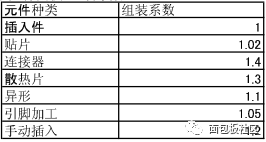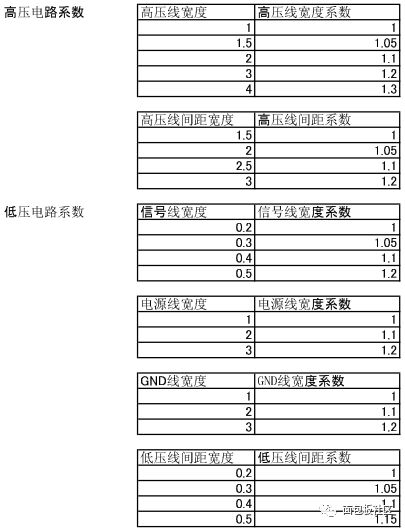Write today about circuit board area estimates. Each designer will probably have an own method to analyze the board area.
Here, I only provide a template for designers who do not have an estimate formula, for reference only. For board area estimation, you need to know some necessary coefficients. 1.Assembly Factor The required assembly area for the assembly of the component = area of ​​the germanium component × assembly factor

Manual insertion: plug-ins manually, this time we must consider the gap left by the movement of the fingers.
2. The coefficient of the minimum line width and spacing of the circuit coefficients. The larger the coefficient, the larger the board area. High-voltage circuit coefficient = High-voltage line width coefficient × High-voltage line spacing coefficient Low-voltage circuit coefficient = Signal line width coefficient × Power line width coefficient × GND line width coefficient × Low-voltage line spacing coefficient

3. Layer coefficient

4. Area Calculation Formula Total Assembly Area = Assembly area of ​​the components in the low voltage area + Assembly area of ​​the components in the high voltage area Assembly area of ​​the components in the low voltage area = Assembly area of ​​the components in the low voltage area × Low voltage circuit factor. The total assembly area of ​​the high voltage area = the assembly area of ​​the high voltage area and × the high voltage circuit coefficient. Other Area Specified General Mounting Prohibited Area General Area of ​​Assembly Blocked Area Board Estimated Area = Component Assembly Area x Layer Factor + Assembly Area Prohibited Area Area Assembly Limit Factor = Area Estimated by Board / Area Specified by Circuit Board ≤ 1, Normally 0.8 or Less, or It is easier to arrange the position of the components.
The following is a concrete example analysis, taking the components in the "Introduction to circuit board design: learn these two measures, easy to get the list of electrical networks" as an example.
Circuit board area estimation example analysis
1. Component Assembly Area The method for calculating the individual area of ​​a component is simply divided into a rectangle and a circle according to the projection of the component on the circuit board. x and y represent the length and width of a rectangular element, and d represents the diameter of a circular element.

2. Circuit coefficient


Here because only the low voltage is involved, the circuit coefficient is only the low voltage circuit coefficient part is 1.1025
3. Layer coefficient

Component Assembly Area × Layer Factor = 565 × 1.1025 × 1 ≈ 630
The general installation prohibition area is estimated to be 684, (only when 630 is split into 30mm × 21mm, other splits will give different estimates.)
Add 3mm to each side and the component is forbidden. (36× 27-630) × 2
Here × 2 is because both sides of the board are set to the component prohibited area. The estimated area of ​​the circuit board is 1350 (rounded to 1314) 1314=684+630 The feasible area of ​​the circuit board design, the coefficient is 0.8, 1350/0.8 = 1687.5≈1700mm2
For this area, the design is relatively loose. It is possible to hold the plate with a length of 50mm and a width of 34mm with the product designer. If the product design does not allow, it can only tighten the waistband, set to 0.9, or 1. Then the coefficient of more than 1 can not be, but also barely, you need to spend more energy and time on components and wiring.
In addition, according to the estimated area of ​​the circuit board, it is checked whether the circuit board size requirement given by the product designer is reasonable.
·Basic precautions
Do not put expensive oil into low-quality cartridges to avoid wastage. Most pre-filled oil cartridges have the so-called 510 thread. The oil cartridge screws onto a rechargeable battery. Some of these batteries have buttons and some heat up automatically when you pump the oil. Some batteries have multiple temperature settings and some heat up to a preset temperature; these features need to be known in advance.
·Cleaning notes
Use a suitable cleaning tool to clean them, such as activated charcoal or dried tea leaves in a used pipe to absorb the oil. It is important not to use alcohol or other boiling water to clean the pipe, and to wait until it has cooled down completely before cleaning. Otherwise, the hot stem will come into contact with the watery liquid and cause the mouthpiece tenon to loosen, thus shortening the life of the 510 cartridges.
This is what you should be aware of when using 510 cartridges. At the same time, when using 510 cartridges, there are still some vaping tips, for example, when using them, be careful not to suck too hard, will not produce smoke. When you inhale too hard, the smoke is sucked directly into your mouth and not atomized by the atomizer, so gently inhaling is more powerful and gives you a better vaping experience.
510 Cartridge Oem,Leakproof 510 Cartridge,510 Battery And Cartridges Oem,510 Cartridge
Shenzhen MASON VAP Technology Co., Ltd. , https://www.e-cigarettefactory.com